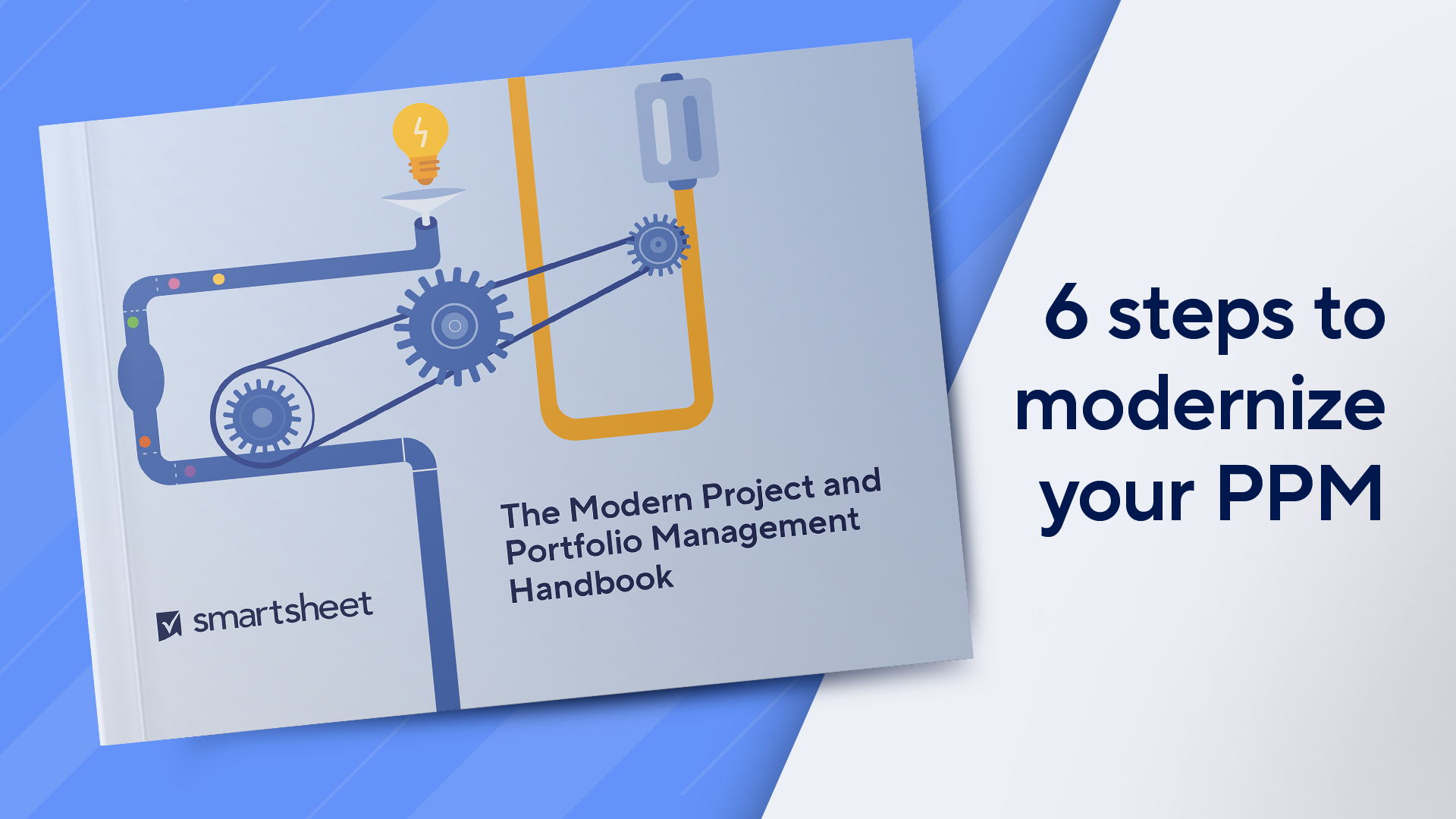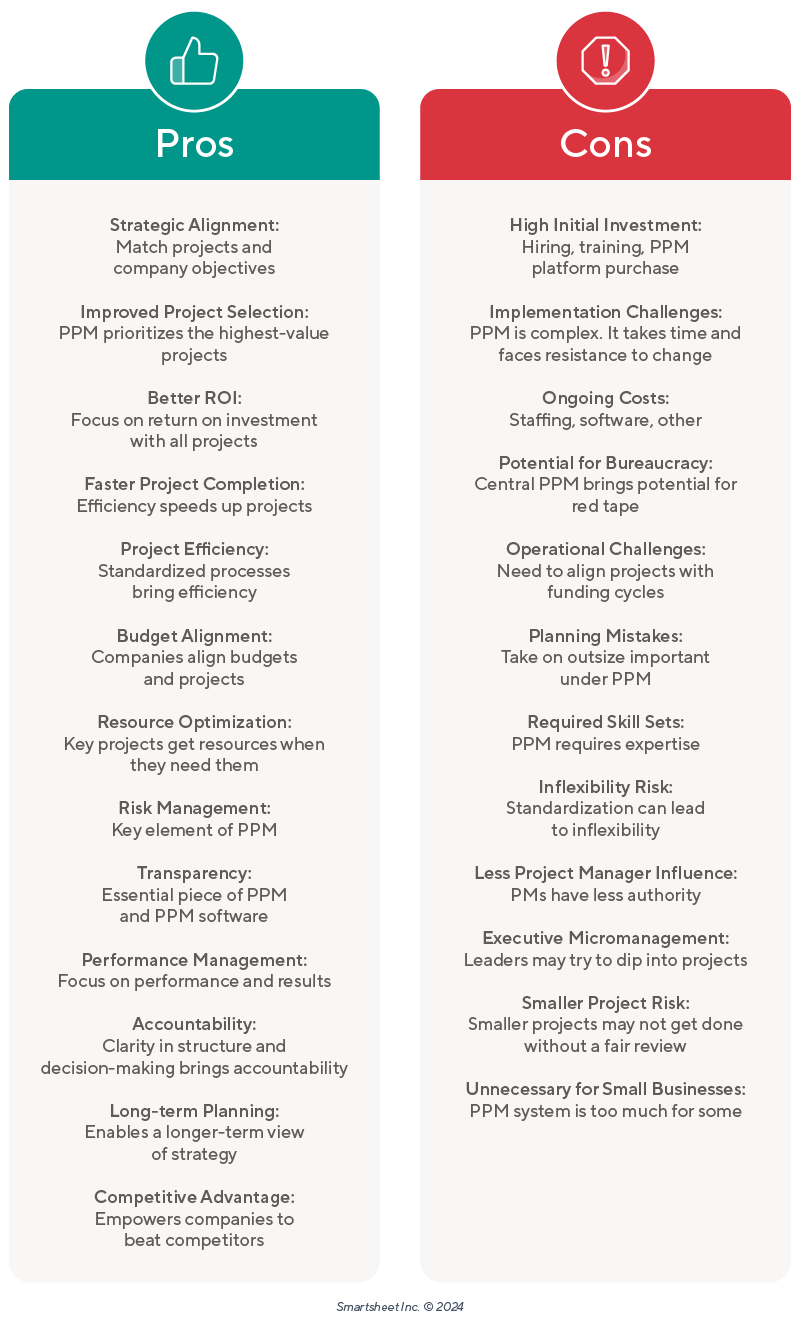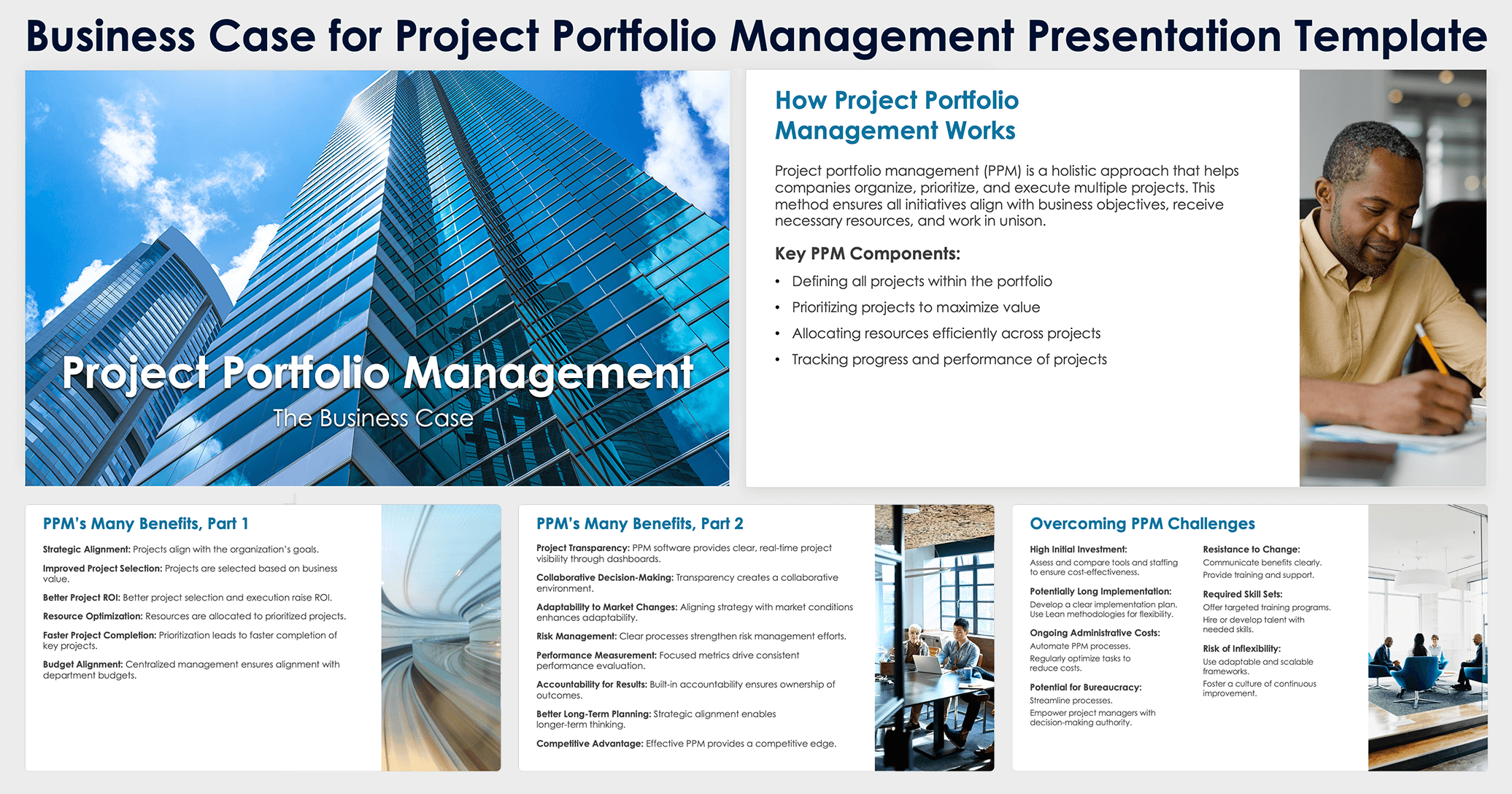Importance of Project Portfolio Management
Project portfolio management (PPM) helps companies organize, prioritize, and execute multiple projects. This method ensures all initiatives align with business objectives, receive necessary resources, and work in unison.
Project portfolio management provides a standardized methodology, enabling projects to proceed according to established criteria. Ultimately, this serves a company’s strategic goals and bottom line.
Without PPM, worthwhile projects may fall prey to siloed thinking, lack of resources, inadequate prioritization, or internal conflicts.
“As a project manager, I’ve found PPM especially effective in matrixed organizations, where cross-functional collaboration is critical,” says Lulu Richter, Senior Technical Project Manager at Smartsheet. “Siloed teams can be more effective in their specific functions but lack insight into other teams’ initiatives. Many times, I’ve seen projects entirely derailed because their goals and objectives conflict with those of another team.”
The Modern Project and Portfolio Management Handbook
A modern approach to project and portfolio management can help equip you and your teams to tackle projects and programs at scale.

This handbook will help you:
Identify pain points in your current processes
Learn from examples of businesses using modern PPM strategies
Implement your own updated PPM strategy
What Are the Benefits of Project Portfolio Management?
The many benefits of project portfolio management start with strategic alignment. Businesses focus on a set of projects that drive business goals. This increases impact, efficiency, and ROI. In the long term, PPM makes a company more profitable and competitive.
“The point of portfolio management is simple,” says Alan Zucker, a project management professional with more than 25 years of experience. “It's identifying the organization's strategic objectives and allocating the money to support them, then providing the right level of governance and reporting ensures we realize the intended benefits.”
Here’s a detailed look at the benefits of project portfolio management:
- Strategic Alignment: PPM ensures all projects align with the company’s strategy and objectives. Instead of departments launching isolated projects, PPM takes a holistic view, prioritizing projects that best meet company goals.
With PPM, projects can build on each other, becoming more than the sum of their parts. In his 2006 book Project Portfolio Management: A Practical Guide to Selecting Projects, Managing Portfolios, and Maximizing Benefits, author Harvey A. Levine writes: "The core mistake is to think that PPM is fundamentally the management of multiple projects. This definitely is not so. PPM is the management of the project portfolio so as to maximize the contribution of projects to the overall welfare and success of the enterprise."
Zucker suggests starting with “why” to keep the PPM focus on strategic alignment. “When consulting with clients, I ask, ‘Why are you executing this project? What are you hoping to achieve? How does it align with your organization’s strategy and goals?’”
At its largest level, PPM is also known as enterprise project portfolio management, meaning it oversees all projects tying into a company’s business goals. In the IT world, there’s IT project portfolio management. Learn more about these practices in this guide to enterprise PPM and this article on IT PPM strategies.
PPM can also tie in with the related concept of product portfolio strategy with product-centered projects. Both try to align work with company strategy. See this guide to product portfolio strategy to find out more. Zucker and other experts also use the term Lean product portfolio management to capture the idea of applying Lean thinking to PPM.
- Improved Project Selection: Companies select projects based on their strategic alignment and potential ROI, ensuring that the most valuable projects receive the resources they need.
“In a good PPM solution, your project is always evaluated within the context of the larger portfolio goals,” Richter says. “As a result, it becomes easier to prioritize the highest-value work, allocate resources effectively, and identify potential conflicts with other projects.”
- Higher ROI: PPM emphasizes return on investment (ROI), ensuring that every project demonstrates its potential return. This focus typically increases the average project ROI over time. If ROI doesn’t improve immediately, PPM enables transparency and accountability to improve over time.
“The benefit of a well-executed PPM strategy is delivering on projects that will provide the most return on investment for the organization,” says Joe Pusz, Founder and CEO of The PMO Squad. “Far too often, a manager initiates a project because a leader wants localized improvement within their department, even when the project provides minimal value to the greater organization.”
- Faster Project Completion: Key projects receive timely resources to keep them moving and meeting deadlines. Project portfolio management software also enables transparency, which tends to speed up projects.
“We’ve seen about a 15 percent decrease in the average length of our projects since using a portfolio project management strategy and collaborative PPM software,” says John Li, CTO of Fig Loans. “Almost every piece of our projects goes more quickly, from project choice to strategy planning and execution. Now that we have information flowing in and out of one integrated source, management and key players can better tie our project strategy to the actual execution. In a nutshell, with the key players all having a clear vision of tasks and strategy, we complete more projects on time and within budget.”
- Improved Project Efficiency: Standardized processes increase efficiency and productivity. PPM prevents projects from being siloed and ensures they have the necessary resources. Without project portfolio management, projects tend to operate in isolation and clash with each other.
“The benefits of developing and maturing a PPM process represent a continuum,” Zucker says. “At one extreme is chaos; money is spent on projects with no control, alignment, or accountability. At the other end of the spectrum, there would be an efficient and transparent process. The enterprise can effectively manage its investments to ensure alignment and maximize its investments. There would be transparency into the status of projects and programs so that appropriate corrective actions would be taken if there are problems.”
- Budget Alignment: Project portfolio management aligns project timing with department budgets while allowing flexibility for market changes. PPM also helps to flag pending cost overruns.
- Resource Optimization: PPM’s centralized view of resources allows timely allocation to projects, reducing delays. Project teams will likely still feel competition for resources, but now there’s a standardized method for evaluating which projects get them and when. Resources may include people, funding, and technology.
- Improved Risk Management: Project portfolio management establishes criteria for evaluating risks. These risks often start with the company’s overall strategy, then filter down through chosen projects. PPM takes a holistic, analytic view of risk and helps manage it effectively.
- Increased Transparency: PPM creates transparency through regular reporting and dashboards, allowing everyone to see project progress. This transparency is a centerpiece of PPM software.
- Better Performance Measurement: PPM enables tracking of key milestones and results across all projects and provides lessons for continuous improvement so companies can achieve operational excellence.
- Higher Accountability: By setting success criteria and measuring results, project portfolio management encourages a performance-based work culture.
For best results, Zucker recommends giving decision-making power to those closest to the work. “When we push decision-making up, then people that are close to the work aren't accountable. It's like, why should I worry? Because my director or my VP made that decision. But if you push decision-making down, people own it, and they feel responsible. They make the right decisions.”
Longer-Term Planning: PPM aligns objectives and results, setting the stage for longer-term planning. With clarity on what they’ve achieved in a year, companies can now look further ahead.
“In any organization where there are a large number of projects operating simultaneously, portfolio project management helps teams align on strategic goals, reduce inefficiencies, and build effective long-term plans,” Richter says.
What Are the Disadvantages of Project Portfolio Management?
The main disadvantage of project portfolio management is the initial investment, but experts agree that PPM typically has a high ROI over time. Other disadvantages include the potential for bureaucracy and resistance to change, which teams can address using time-tested methods.
Here’s a more complete look at the disadvantages of PPM and how businesses can overcome them:
- High Initial Investment: Project portfolio management requires a significant initial investment in people, training, and technology. Companies likely will need new people with PPM expertise. They will also need to purchase a PPM platform and train existing staff to use it.
Teams can conduct a cost-benefit analysis to assess whether the potential efficiencies and strategic advantages gained from implementing PPM outweigh the initial setup and operational costs.
- Implementation Challenges: PPM implementation can be time-consuming due to its complexity and some people’s general resistance to change. It may also initially lower productivity until it takes root.
“Project portfolio management is a simple concept, but can be incredibly difficult to implement,” Richter says. “A PPM solution needs to work at every level of the organization and be adapted to dramatically different audience types. It can be time-consuming to create and maintain the system required to support true PPM. Even the best portfolio management framework can fall apart if there isn’t total buy-in from the teams expected to work within it.”
Zucker emphasizes overall Lean thinking as a way to overcome PPM challenges: “Lean portfolio management is a reaction to a lot of the problems that we'd seen in the traditional view of portfolio management — for example, creating flow, pushing decision-making down, and eliminating waste.”
For details on how PPM works, see these guides on implementing PPM effectively and PPM processes, phases, and workflows.
- Ongoing Administrative Costs: Project portfolio management has ongoing administrative costs that may or may not be higher than a company’s previous project efforts. These costs could include team members with PPM expertise, including a PPM VP or director. There’s also the cost of the technology and maintaining it. The idea is to offset any increased costs with increased ROI.
- Bureaucracy: PPM can lead to time-wasting bureaucracy if organizations don’t focus on efficiency and productivity.
Zucker gives this example: “One company I worked with had an enterprise portfolio management organization. They implemented and customized an enterprise tool. When a member of the PPM team attended an industry conference, they saw a vendor demo and realized they balled up the tool's implementation.”
He says the PPM team had 50-75 people, including a senior vice president, a couple of VPs, and several directors. “The intention was to create oversight and standardization. But things just became bureaucratic,” he says.
The remedy lies in Lean approaches to PPM. “Portfolio management, like everything else, should be an evolving art,” he says. “We started with our traditional approaches, but they became bureaucratic and inefficient. We're now modifying that with Lean. Hopefully, we will continue to improve and evolve the processes and practices. When we see things that do not work, we should change them. Make them simpler instead of more complicated.”
- Funding Overload: With PPM, annual funding cycles might lead to excessive project requests and resource commitments, resulting in teams being overwhelmed and unable to complete projects effectively.
“Traditionally, organizations have annual funding cycles,” Zucker says. “A lot of time and effort is expended developing project requests and budget justifications. Teams request two or three times more money than they could reasonably spend under the expectation that the request would be halved. Then, at the beginning of the year when the funds are released, teams start executing more projects than they can effectively manage. Everyone is very busy, but projects are not getting completed.”
“To improve the process,” he continues, “we can take lessons from Lean. Rather than having effort-intensive annual funding processes, simplify everything. Move to a rolling funding model. Push tactical funding decisions down to the lowest responsible level in the organization. Create pull and do not start a new project until the teams have the capacity to deliver it.”
- Mistakes in Planning: PPM relies on accurate data projections, and mistakes made during planning can have significant impacts. This happens with any project method, but it can become more pronounced with PPM at a large company.
- Required Skill Sets: An organization may need to hire people with PPM expertise to implement and run this new approach, which can be expensive and time-consuming. However, just as the increased administrative costs can be offset with a high ROI, the benefits of the training can be extensive. For example, team members can use the training as an opportunity for professional growth.
- Inflexibility: Standardization can lead to a one-size-fits-all approach, which may not suit every project. An organization needs to apply the right criteria to recognize nuances between departments and projects. Project managers attached to particular departments often have a good view of these nuances, and it pays to listen to them while implementing PPM.
- Low Project Manager Influence: Depending on the company’s structure, project managers may lose influence and some decision-making authority in a PPM system. This is also true of departments as a whole.
However, this doesn’t happen in all companies, and it can pay to listen to your project managers and give them authority. Zucker gives this example from personal experience: “At one point in my career, I managed an organization with 175 project managers,” he says. “I recognized that there was no way I could keep track of the 150 or so projects that were in process at any given time. So I told my managers that they were responsible for each of their portfolios. I only asked that they let me know before a project went sideways so we could collaborate on the solution. I was there to support them. And it worked great.”
- Executive Micromanagement: PPM tools and dashboard metrics can lead to centralized decision-making and micromanagement. Ground rules are necessary to delineate who has decision-making authority.
“The PPM tools, metrics, and reports only tell a small part of the story,” Zucker says. “To understand how a project is performing, you need to talk to the team to understand what is happening on the ground.”
He gives this example of micromanagement: “I worked for a vice president who was a micromanager. He would read the 300-page report that came out of the PPM system each week. That was a huge waste of his time. He should have created an environment where people felt comfortable raising issues and concerns directly to him.”
- Overcomplication: PPM may be too complex for smaller businesses with fewer projects. However, PPM practices may help with strategic alignment even in small businesses.
“Like any project, potential benefits need to be evaluated against the cost; project portfolio management will not work in every scenario,” Richter says. “If you’re struggling to align functional teams with larger strategic goals, PPM can be a powerful tool to transform the way you work.
Project Portfolio Management Pros and Cons Quick Reference Guide
Here’s a quick review of the advantages and challenges of project portfolio management.

Download the Project Portfolio Management Pros and Cons Quick Reference Guide for
For more free resources, download one of these project portfolio management templates — including a PPM summary template, a dashboard template, and a status report template — to use in your planning. You can also try one of these product portfolio management templates, such as a timeline roadmap template for multiple products, a product comparison template, or a bubble diagram for risk analysis.
Making the Business Case for Project Portfolio Management
To make the business case for PPM at your company, highlight its many benefits while addressing potential challenges. Emphasize the long-term ROI and strategic advantages. Conduct preliminary research with stakeholders to understand current project management issues. Then, prepare a formal presentation addressing these points.
PowerPoint Slides to Make the Business Case for Project Portfolio Management

Download a Business Case for Project Portfolio Management Template for
PowerPoint
| Google Slides
When to Use This Template: Use this template to present a business case for implementing PPM within an organization. It outlines the benefits, solutions to common challenges, and steps for implementing PPM, making it suitable for convincing stakeholders of its value and guiding the implementation process.
Notable Features: This template features a comprehensive structure that covers all critical aspects of PPM, including assessment, planning, tool selection, and continuous improvement. It emphasizes strategic alignment, outlines benefits, addresses common challenges with solutions, and promotes a data-driven, collaborative decision-making culture.
Streamline Project Portfolio Management with Smartsheet for Project Management
From simple task management and project planning to complex resource and portfolio management, Smartsheet helps you improve collaboration and increase work velocity -- empowering you to get more done.
The Smartsheet platform makes it easy to plan, capture, manage, and report on work from anywhere, helping your team be more effective and get more done. Report on key metrics and get real-time visibility into work as it happens with roll-up reports, dashboards, and automated workflows built to keep your team connected and informed.
When teams have clarity into the work getting done, there’s no telling how much more they can accomplish in the same amount of time. Try Smartsheet for free, today.


